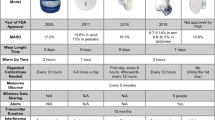Summary
We investigated the direct effects of physiological levels of epinephrine on the basal and arginine-stimulated secretion of insulin, glucagon, and somatostatin from the in situ pancreas in halothane-anaesthetized dogs.
An IV infusion of 20 ng/kg/min of epinephrine increased plasma epinephrine levels to 918±103 pg/ml (P<0.001), and increased the baseline pancreatic output of insulin (P<0.05), glucagon (P<0.05) and somatostatin (P<0.05). The acute insulin response (AIR) to 2.5 g of arginine during this infusion of epinephrine was significantly higher (P<0.05) than in controls as were the acute glucagon response (AGR) (P<0.05) and the acute somatostatin response (ASLIR) (P<0.05). Plasma glucose levels increased slightly and transiently during infusion of epinephrine from 99±2 mg/dl to a maximum of 110±3 mg/dl (P<0.05).
An IV infusion of 80 ng/kg/min of epinephrine produced plasma epinephrine levels of 2948±281 pg/ml, and increased the baseline pancreatic output of insulin (P<0.05) and glucagon (P<0.05). In contrast, baseline somatostatin output decreased transiently during this high dose infusion of epinephrine. The AIR and ASLIR to arginine were both significantly lower (P<0.05) than those during the infusion of epinephrine at the low dose. The AGR to arginine remained potentiated (P<0.05). Plasma glucose levels increased from 99±3 mg/dl to 119±4 mg/dl (P<0.01).
We conclude that the effect of epinephrine on islet hormone secretion is dependent on the plasma level of epinephrine. At stress levels of 900–1000 pg/ml, both insulin and somatostatin secretion are stimulated; only at near pharmacologic, or extreme stress levels, does epinephrine produce net inhibition.
Similar content being viewed by others
References
Gray DE, Lickley HLA, Vranic M. Physiologic effects of epinephrine on glucose turnover and plasma free fatty acid concentrations mediated independently of glucagon. Diabetes 1980;29:600–608.
Eigler N, Sacca L, Sherwin RS. Synergistic interactions of physiologic increments of glucagon, epinephrine, and cortisol in the dog. J Clin Invest 1979;63:114–123.
Gauthier C, El-Tayeb K, Vranic M, Lickley HLA. Glucoregulatory role of cortisol and epinephrine interactions. Studies in adrenalectomized dogs. Am J Physiol 1986;250:E393-E401.
Taborsky GJ Jr, Ensinck JW. Contribution of the pancreas to circulating somatostatin-like immunoreactivity in the normal dog. J Clin Invest 1984;73:216–233.
Cryer PE. Physiology and pathophysiology of the human sympatho-adrenal neuroendocrine system. N Engl J Med 1980;303:436–444.
Morgan CR, Lazarow A. Immunoassay of insulin: two antibody system. Plasma insulin of normal, subdiabetic and diabetic rats. Diabetes 1963;12:115–126.
Tager HA, Hohenboken M, Markese J. High titer of glucagon antisera. Endocrinology 1977;100:367–372.
DeHaen C, Little SA, May JM, Williams RH. Characterization of proinsulin-insulin intermediates in human plasma. J Clin Invest 1978;62:727–737.
Colon JM, Bridgeman M, Alberti KGMM. The nature of big plasma somatostatin: Implications for the measurement of somatostatin-like immunoreactivity in human plasma. Anal Biochem 1982;125:243–252.
Evans MI, Halter JB, Porte D. Jr. Comparison of double and single-isotope enzymatic derivative methods for catecholamines in human plasma. Clin Chem 1978;24:567–570.
Samols E, Weir GC. Adrenergic modulation of pancreatic A, B and D cells. α-Adrenergic suppression and β-adrenergic stimulation of somatostatin secretion, α-adrenergic stimulation of glucagon secretion in the perfused dog pancreas. J Clin Invest 1979;63:230–238.
Efendic S, Luft R, Cerasi E, Quantitative determination of the interaction between epinephrine and various insulin releasers in man. Diabetes 1978;27:319–326.
Beard JC, Weinberg C, Pfeifer MA, Best JD, Halter JB, Porte D. Jr. Interactions of glucose and epinephrine in the regulation of insulin secretion. Diabetes 1982;31:802–807.
Porte D. Jr. A receptor mechanism for the inhibition of insulin release by epinephrine in man. J Clin Invest 1967;46:86–94.
Perez G, Kemmer FW, Lickley HLA, Vranic M. Importance of glucagon in mediating epinephrine-induced hyperglycaemin in alloxandiabetic dogs. Am J Physiol 1981;241:E328-E335.
Iversen J, Adrenergic receptors and the secretion of glucagon and insulin from the isolated, perfused canine pancreas. J Clin Invest 1973;52:2102–2116.
Gerich JE, Karam JH, Forsham PH. Stimulation of glucagon secretion by epinephrine in man. J Clin Endocrinol Metab 1973;37:479–481.
Perez G, Ungaro B, Covelli A, Morrone G, Lombardi G, Scopacasa F, Rossi R. Altered glucoregulatory response to physiological infusions of epinephrine and glucagon in hyperthyroidism. J Clin Endocrinol Metab 1980;51:972–977.
Clutter WE, Bier DM, Shah SD, Cryer PE. Epinephrine plasma metabolic clearance rates and physiological thresholds for metabolic and hemodynamic actions in man. J Clin Invest 1980;66:94–101.
Sacca L, Morrone G, Cicala M, Corso G, Ungaro B. Influence of epinephrine, norepinephrine, and isoproterenol on glucose homeostasis in normal man. J Clin Endocrinol Metab 1980;50:680–684.
Beard JC, Weinberg C, Pfeifer MA, Best JD, Halter JB, Porte D. Jr. Modulation of arginine-induced glucagon release by epinephrine and glucose levels in man. J Clin Endocrinol Metab 1983;56: 1271–1277.
Author information
Authors and Affiliations
Rights and permissions
About this article
Cite this article
Ahrén, B., Veith, R.C. & Taborsky, G.J. The effects of epinephrine on islet hormone secretion in the dog. Int J Pancreatol 3, 375–388 (1988). https://doi.org/10.1007/BF02788471
Received:
Accepted:
Issue Date:
DOI: https://doi.org/10.1007/BF02788471




